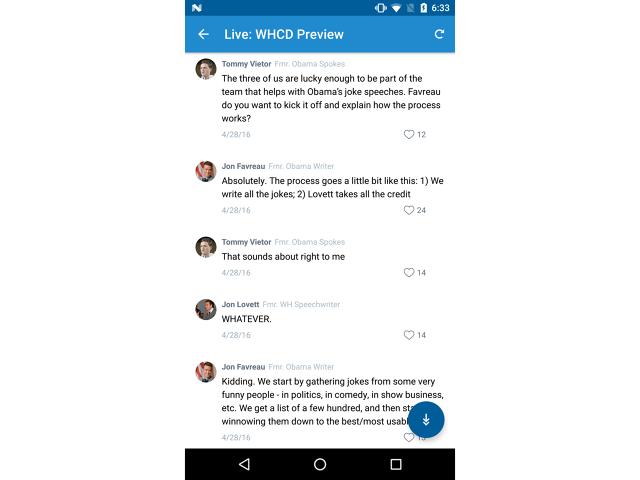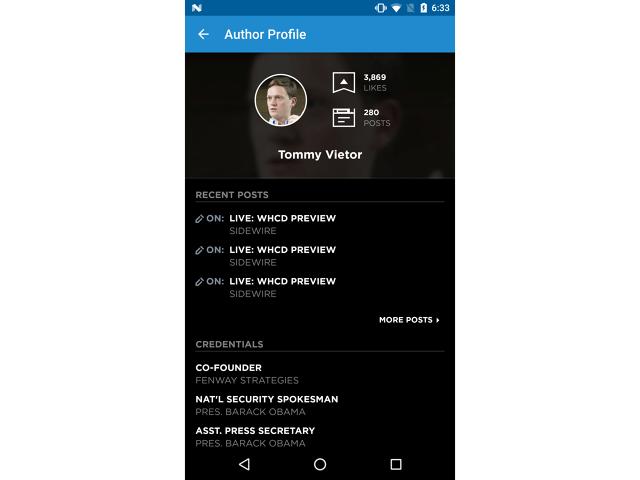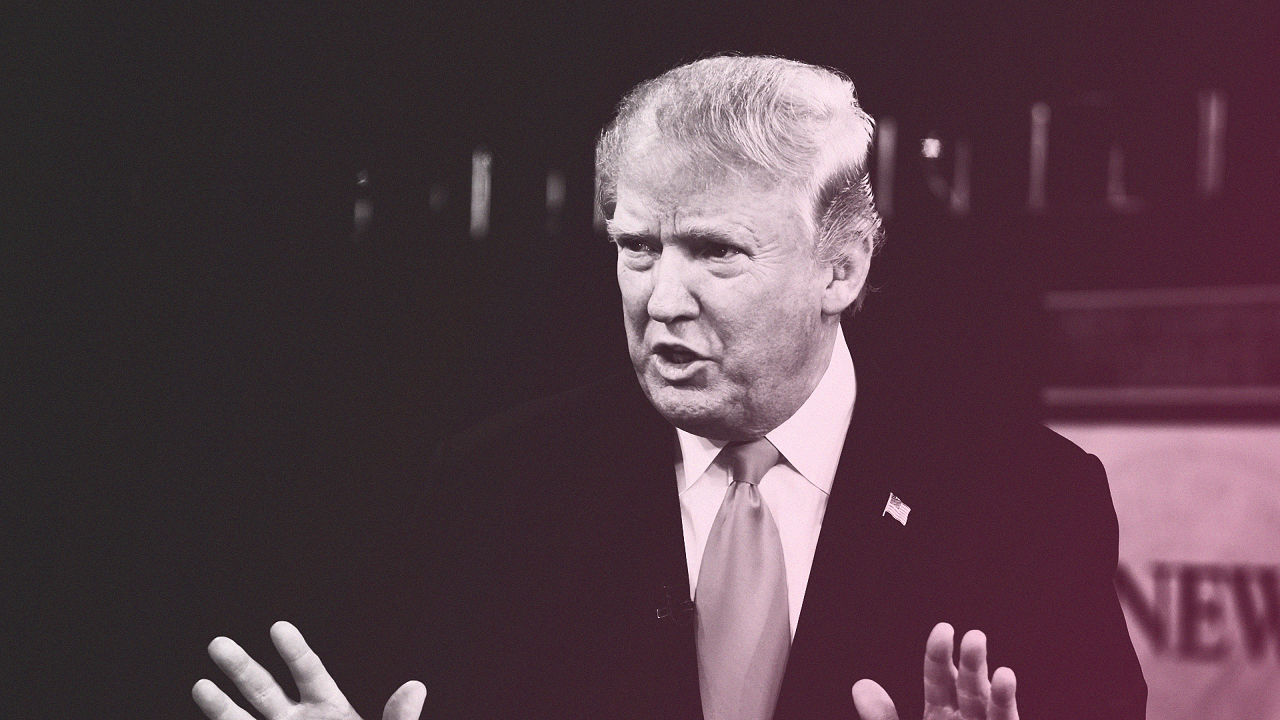This App Is The Antidote To This Insane Presidential Campaign
It’s the night of the Indiana primary, and I’m at a cool, new D.C. hangout called Sidewire. The polls close, and with the almost immediate call for Donald Trump, the place erupts into compelling conversation. Ron Facheaux, a former Louisiana state legislator who now runs a political research group, is the first to say it: “Ladies and gentlemen, the fat lady has sung.” Dr. Ben Carson’s spokesperson Shermichael Singleton goes deep on the exit polling, noting that “Trump wins with evangelicals, those worried about the economy, college educated, etc. Cruz’s message just isn’t resonating with Republican voters.” As the conversation veers into exploring a third-party conservative candidacy, Travis Considine, Governor Rick Perry’s former press secretary, says, “I bet Sen. Cruz bows out tonight.” Minutes later, it happens.
Eavesdropping on what a cadre of top politicos—strategists, speechwriters, congresspeople, political scientists, journalists, and the like—make of the madness is thrilling. Smart, fun, and spirited, it’s the 180-degree opposite of the kabuki theater of cable news “debate,” or the sure-to-devolve and difficult to follow political conversation on social media. At Sidewire, “you can have a more fun conversation without people tweeting Benghazi photos at you all day long,” says Tommy Vietor, cofounder of Fenway Strategies and a veteran of the 2008 Obama campaign.
Sidewire is not a bar or a private club, but an app, newsletter, and website—the product of an early-stage, San Francisco-based startup of the same name. Sidewire’s mission is to create a place where informed “newsmakers,” as it calls its contributors, have a clean, well-lit place to share their insights and have civilized conversations.
Today, Sidewire, which launched just last September, is rolling out Sidewire Chats, a product that makes it easier for the people in its community to initiate and host an exchange around a topic. It takes what everyone on the platform agrees is the best part of Sidewire—focused conversations between knowledgeable people—and packages them deftly into its own media format that can be easily consumed and shared.
“There are plenty of places online to trash people,” says Jonathan Allen, Sidewire’s head of content and community. “We’re tired of the debate being brought down. It’s better to say something smart and see how much better you can make the conversation.” Because only invited professionals can post, Sidewire is a service where the signal-to-noise ratio actually can’t be calculated, because it’s against the laws of mathematics to divide by zero. There is no noise inside Sidewire. Folks like me are there only to enjoy the dialogue.
The idea that you can create a home for elevated political discourse in this election cycle—one in which Trump trolls rivals via Twitter and is now the presumptive Republican nominee and even President Obama uses the forum of the White House Correspondents Dinner to settle scores—isn’t just counterintuitive, it feels downright quixotic. In this context, Sidewire seems both more necessary and more anomalous.
And yet new digital communications tools and presidential races have become synonymous. “Every election is a proving ground for new technology,” says Sidewire cofounder and president Tucker Bounds. He’s right: Blogging arose out of the 2000 and 2004 elections; Twitter and Facebook helped define 2008; next-generation data mining, microtargeting, and email marketing were central to the 2012 race. If you had had to predict a tech front-runner as the campaign heated up, you’d have bet on live streaming video or Snapchat. You also would have bet on Jeb Bush, Marco Rubio, or maybe Ted Cruz. Sidewire is an early-stage startup that is just now starting to emerge into what it might ultimately become. Writing about it now is akin to predicting what Trump’s campaign would become around the time he was insulting Sen. John McCain. But in this election, where the next surprise is seemingly never more than an hour away, what if chat conversations become the new media? Crazier things have happened.

Bounds, 37, fits the archetype of what venture capitalists salivate over: An entrepreneur uniquely qualified to solve a problem. The friendly, 6’4″ redhead spent his 20s rising through the ranks of Republican politics until he was the national spokesperson for the McCain-Palin campaign before his 30th birthday. “He was always making my life harder, driving me crazy,” says Vietor, who at the time was part of the rapid-response communications for the Obama campaign. “He always cared about what’s next,” says Mike Murphy, the Republican strategist who worked with Bounds during Meg Whitman’s 2010 gubernatorial bid. “He understood the rise of the virtual precinct on social media when a lot of Republicans were slow to get it.”
Bounds’s exposure to Whitman and her team from eBay sparked his entrepreneurial inclinations. “He’d been steeped in politics and policy,” says Henry Gomez, who has worked with Whitman for 16 years and is currently CMO and chief communications officer of HP Enterprise. “He got to see Meg at work, wired for business, working at that pace. He hadn’t experienced that before.” When the campaign was over, rather than find the next race to work on, Gomez says he told Bounds, “Go work in the Valley.”
Given Bounds’s growing interest in tech, “when he wound up at Facebook,” Murphy says, “it was no surprise.” Bounds arrived at the social network in 2011, and spent three years there witnessing the company’s mobile transformation. By 2014, he was part of a team working on what was then called “public content,” which included its early efforts to become a more real-time platform. “I had the expertise and understanding of how elections work,” says Bounds, “and then I had a front-row seat to the reorganization of social media around news and real time.”
All the while, he kept thinking about creating his own company, even though communications professionals do not become startup founders. Founders of PR agencies, sure. But product-based companies? “I thought he was crazy,” says Shannon (Stubo) Brayton, LinkedIn’s CMO and SVP of communications and an advisor to Sidewire. Even Bounds admits that he had a big obstacle to overcome as a founder: “I don’t know how to build anything.”
Then a friend told Bounds, “I know this young guy at Stanford.” If Bounds represents one pole of VC catnip, Andy Bromberg represents the other, what Y Combinator cofounder Paul Graham once jokingly categorized as “I can be tricked by anyone who looks like Mark Zuckerberg.” Bromberg doesn’t physically resemble the Facebook CEO—he’s stockier, dark-haired, and bespectacled—but like Zuckerberg, he is the son of professionals who grew up in an affluent suburb of a major Eastern hub. Bromberg had a successful digital marketing business in high school in Concord, Massachusetts, and matriculated at Stanford where he studied math and computer science. “I didn’t know Andy was 19,” says Bounds of their first meeting in 2014. That means that when the preternaturally youthful Bounds was on TV representing Senator McCain and looking about 13 years old in his blue blazer and repp tie, Bromberg actually was 13.
“Have you met Andy?” was a question I heard repeatedly during my reporting. “You’re going to be blown away,” Vietor tells me. “The first time we had a beer, he recommended some ‘light reading’: Godel, Escher, Bach, a 700-page treatise. He’s finished it. I have not!”
“He’s so sharp, mature, and grounded,” Brayton says. “When I met Andy, I told Tucker, ‘You should go with him.’ ” In the summer of 2014, Bromberg took a leave from Stanford after his sophomore year to cofound Sidewire, and Bounds left Facebook.
Bromberg, who’s now 21, serves as CEO, befitting both his engineering talent and boy genius status. He and Bounds have what are universally described as completely complementary skill sets. Bromberg brings a recruiting pipeline into Stanford, the ability to manage product development and solve tech problems, and burgeoning management skills. Bounds had the communications and strategy skills he’d developed and a completely different network of political and tech-world players who could help Sidewire. More than one person describes the duo as having a “Mark and Sheryl-style” relationship, akin to Facebook’s CEO and COO, and it’s their dynamic that makes Sidewire a more interesting project than if either one were pursuing it independently.

“Open-seat presidential elections are always exciting,” says Bounds, who of course participated directly in our last one in 2008. Launching Sidewire for the 2016 campaign “would allow us to tinker over months to figure out the product. This only turned out to be truer than we ever thought!”
Bounds, Bromberg, and I are chatting in Sidewire’s office space in a cool commercial real estate development in San Francisco’s Jackson Square neighborhood. It’s the day of the New York primary, but it’s late afternoon before the polls have closed, so you’d never necessarily know it. The TV is off, and everyone has their face buried in a monitor. For a startup that is still “10 employees and a pizza box,” as Bounds self-effacingly puts it, he’s hustled his way into some fancy digs. Sidewire is decamped in the office of a local family foundation, with lots of rich wood and exposed brick. Pictures of vintage motorcycle racing dominate the walls. The conference room is decorated images of celebrities and their bikes, and two vintage racing motorcycles, a BMW and a signed MV Agusta that Sidewire employees speculate is worth anywhere from $175,000 to $250,000, command a lot of the open space. Everyone wants me to know that this isn’t yet another sign of startup excess, but it’s the owner’s collection; Sidewire is renting desks month to month. The only indication that this is Sidewire’s offices is a small cache of political bumper stickers for the 2016 candidates as well as for Sidewire itself.
When Sidewire launched in September 2015, it was hard to figure what to make of it. It had an app and a website and a number of contributors signed up to play with it, from Bob Shrum, a longtime Democratic strategist who ran John Kerry’s 2004 presidential campaign, to Tim Hagle, a political science professor at the University of Iowa who is an expert in his home state’s caucus process. It had already hit upon what every newsmaker tells me is their favorite feature: a 250-character limit. “I can write a little longer, take my time,” says Jon Favreau, the former Obama speechwriter who runs Fenway Strategies with Tommy Vietor. Why 250 characters? “It’s three full sentences,” says Meredith Carden, a former staffer for Michelle Obama in the East Wing who now serves as Sidewire’s head of partnerships. “Intro, thesis, conclusion. Not too much and not too little.” (Compare that to the angst among the Twitterati regarding its 140-character limit.) But even with the room for political experts to showcase their knowledge, “it looked like they were writing posts to stand on the Internet somewhere else,” says Kevin Thau, a venture capitalist at Spark Capital and Sidewire’s lead investor.
The company found the beginning of what it now believes is its product-market fit when Senator Lindsey Graham’s office called in November 2015. Graham had just been excluded from even the “kids table” Fox Business/WSJ Republican debate because of low poll numbers and wanted to know if he could use Sidewire to offer live commentary while his rivals were on stage. “We had in-app chat,” says Bromberg, “but this was not the use case the platform was built for.” Seeing an opportunity to get some attention, Bounds, who knew the senator because of his close friendship with his old boss John McCain, said yes. “This was on a Friday,” says Bounds. “The debate was the following Tuesday. Now we had to build it.”
Debate night arrived and the senator and Sidewire were both ready. Graham’s opening salvo: “My advice to the candidates tonight: No matter what, don’t win the debate, they’ll kick you off the stage.” Over the next several hours, he took questions, offered the answers he’d have given if he were on stage, and generally mixed it up. (“Rand: please don’t talk about the military. It’s not your strong suit.”) Graham was delightful and delighted. “Thanks Sidewire—I enjoyed a debate where I could have input and a glass of wine at the same time.”
“That was amazing,” says Bounds. “We realized that we needed to build more Lindsey Graham moments,” says Bromberg. “People hosting discussions as their own unit of content. Everything cascaded from that conversation.”

Bromberg and Bounds did engineer more amazing conversations—a few highlights include Favreau, along with speechwriters for Presidents Clinton and Bush 41, explaining how the State of the Union gets put together; Ron Klain, who helped shepherd Ruth Bader Ginsberg through the Supreme Court nomination process, offered insight on the Merrick Garland pick and the fight to replace Justice Scalia; and the journalists Jacob Weisberg and Kurt Andersen riffed on Trump and Hillary Clinton on the day of the New York primary.
In January, they introduced Today’s Stitch, a daily news roundup put together by veteran D.C. journalist Jon Allen, who also initiates many of the chats on Sidewire. “It’s designed to start the day’s conversation,” says Allen, whose dad was a White House correspondent covering President Reagan. In recent weeks, Bounds has steered Stitch into becoming Sidewire’s “morning show,” as he puts it, with Allen interviewing an author or another newsmaker. When you consider that development along with the effort to schedule more chats to spur participation (and appointment viewing), Sidewire starts to feel a bit like a curated cable network living inside an app.
As the format has gotten more established and these politicos, who usually only know of each other, get more used to it, they’re becoming more relaxed. “It’s starting to match the way we talk about these issues with friends,” says Vietor. “It’s like my iMessage chains all day long.”
It’s this tantalizing prospect that makes Sidewire a big idea worthy of a $4.5 million seed round led by Spark Capital. “Sidewire solves a couple of problems the big social networks have,” says Spark’s Thau, a longtime Twitter executive turned VC who sits on Sidewire’s board. “Why should we listen to you? And it focuses content around a topic.” As Thau notes, the rise of messaging conversations—via Slack, via SMS or other text threads—has gotten us comfortable with this idea. “Chat can stand alone as its own media type. Not posts, chats.” Other startups, such as Talkshow, created by former Twitter product lead Michael Sippey, also embrace the idea of text chat as a distinct media format, but Talkshow, for example, is an open platform where anyone can create a conversation for others to find and follow. It only seeks to solve Thau’s second problem of large social networks, not the first.
Fixing the political discourse, then, is just a good place for Sidewire to start. As both Thau and Mike Murphy, who participated in Sidewire’s friends and family round, explicitly tell me, they only invested because they see Sidewire’s value across multiple categories: entertainment, business, fashion, tech, sports, and so forth. “It’s the quickest, easiest way to get the insiders’ take,” Thau says. “This phase is about getting the mechanics and structures right.”
When I ask any Sidewire employee how they are measuring their traction so far, they nod to some anecdotal sense that the app has been downloaded and is being viewed by folks in D.C. and San Francisco—and then drill down on their focus on the newsmakers. Bounds tells me that they’ve signed up more than 500 of what they believe are 3,000 U.S. politicos who can be considered newsmakers. Bromberg explains that success is currently defined by conversations with a high posts per minute ratio, longer reply chains, and several unique posters within a chat. With the launch of Sidewire Chats, Bromberg and his team are now turning to making it easier for newsmakers to start their own without the assistance or urging of a Sidewire employee and find cohosts and participants to join them in what they want to discuss.
Only after optimizing the experience for contributors will Sidewire turn to improving audience participation this summer. Bromberg suggests he’ll be adding “more fun ways to join in without affecting our overall goal,” even suggesting that Sidewire might allow for some kind of screened call into a conversation, like a radio show.
The reference to replicating and improving upon a call-in radio show belies how Sidewire is suffused with a nostalgia for recapturing a seemingly bygone era. As I read both Democrats and Republicans engaging in productive conversation rather than partisan sniping, I want to light a cigarette and mix myself a Sidecar. When I ask Bounds about his political upbringing as a Republican, he hastens to note that he was “raised in an Oregon Republican household.” He explains his home state’s long history of electing problem solvers, people who were eager and able to work across the aisle with Democrats. That’s what he admired about McCain, too. He tells me how affected he was when he saw McCain become very emotional when Senator Ted Kennedy, the liberal lion from Massachusetts, fell ill. “These [politicians] are human beings, too,” he says. “They work together. They talk to each other person-to-person.”
I suggest that if you want to understand this current political cycle, you can draw a straight line from McCain’s pick of Sarah Palin as his running mate to Donald Trump and his inflammatory rhetoric eight years later. Bounds gets flush, his whole face turning as strawberry blonde as his hair. He shakes his head. He can’t utter the words but his whole body is agreeing with me in its involuntary response.
Sidewire may be a slick app trying to transform texting threads into the next media format, but for Bounds and his newsmakers, it’s a personal attempt to turn the clock back to the politics they want, not the politics we have.
Fast Company , Read Full Story
(23)






